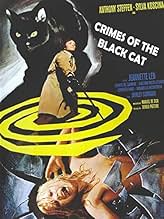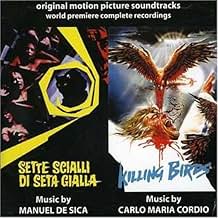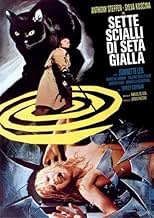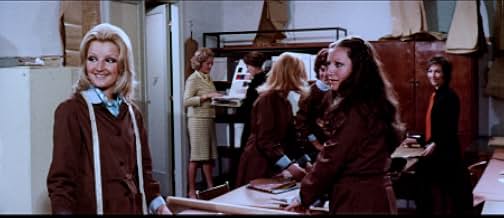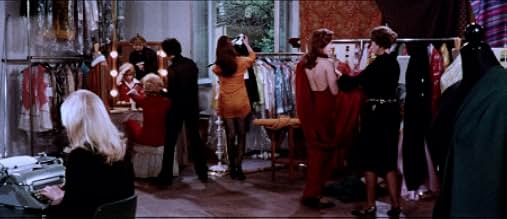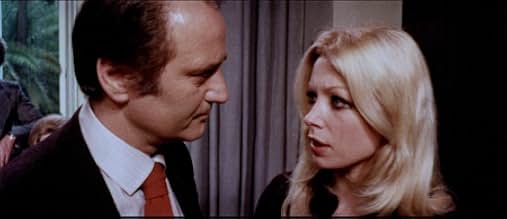AVALIAÇÃO DA IMDb
6,1/10
1,1 mil
SUA AVALIAÇÃO
Adicionar um enredo no seu idiomaA blind pianist overhears a conversation in a nightclub, and is determined to figure out who is responsible for a string of strange murders involving a black cat.A blind pianist overhears a conversation in a nightclub, and is determined to figure out who is responsible for a string of strange murders involving a black cat.A blind pianist overhears a conversation in a nightclub, and is determined to figure out who is responsible for a string of strange murders involving a black cat.
- Direção
- Roteiristas
- Artistas
Giovanna Lenzi
- Susan Leclerc
- (as Jeannette Len)
Isabelle Marchall
- Paola Whitney
- (as Isabelle Marchal)
Lorenzo Piani
- Waiter in Hamburg
- (apenas creditado)
Bruno Alias
- Hairdresser
- (não creditado)
Francesco Anniballi
- Male Nurse
- (não creditado)
Florinda Bolkan
- Carol Hammond
- (cenas de arquivo)
- (não creditado)
Margherita Horowitz
- Atelier personnel
- (não creditado)
Avaliações em destaque
The first half of this giallo is fairly undistinguished, especially since it blatantly copies Mario Bava (the fashion-house setting being lifted, yet again, from BLOOD AND BLACK LACE [1964]) and Dario Argento (borrowing its blind hero-turned-sleuth from THE CAT O'NINE TAILS [1971]). However, the film is stylish enough (particularly the zoom-happy murder sequences) and the plot convoluted enough (taking in a plethora of shady characters invariably involved in adultery, drug-taking, blackmail and revenge) to overcome its basic lack of originality; the circus-world back-story, then, should perhaps excuse its uniquely far-fetched murder method...though the seven yellow-silk shawls referred to in the original Italian title are equally insignificant!
The film's pulsating score by Manuel De Sica (son of neo-realist master film-maker and versatile actor Vittorio De Sica) is serviceable but unremarkable, as is the cast led by Anthony Steffen, Sylva Koscina (in what at first appears to be merely an extended cameo) and Giacomo Rossi-Stuart. Its use of nudity is very discreet (though it doesn't appear that any cutting was done, I haven't been able to establish the film's correct running time; the print I watched was around 94 mins. in PAL format, but some sources list versions running as long as 108 mins.!) and the gore only truly surfaces at the very end (with a particularly nasty shower murder, shamelessly ripping off Hitchcock's PSYCHO [1960] - but remaining, for my money, one of the genre's most memorable set-pieces). After the mystery has supposedly been solved (and the revelation of the killer's identity having thus proved quite lame and lazy, in my opinion), the film manages to pull the rug from under our feet - so much so that I had to watch the ending twice! - by providing one final twist. By the way, the decision to conclude the film in mid-sequence on a freeze-frame is another Argento influence, namely FOUR FLIES ON GREY VELVET (1971)!
All in all, a giallo more interesting in its borrowings than for any individual achievements - but one that remains eminently watchable just the same.
The film's pulsating score by Manuel De Sica (son of neo-realist master film-maker and versatile actor Vittorio De Sica) is serviceable but unremarkable, as is the cast led by Anthony Steffen, Sylva Koscina (in what at first appears to be merely an extended cameo) and Giacomo Rossi-Stuart. Its use of nudity is very discreet (though it doesn't appear that any cutting was done, I haven't been able to establish the film's correct running time; the print I watched was around 94 mins. in PAL format, but some sources list versions running as long as 108 mins.!) and the gore only truly surfaces at the very end (with a particularly nasty shower murder, shamelessly ripping off Hitchcock's PSYCHO [1960] - but remaining, for my money, one of the genre's most memorable set-pieces). After the mystery has supposedly been solved (and the revelation of the killer's identity having thus proved quite lame and lazy, in my opinion), the film manages to pull the rug from under our feet - so much so that I had to watch the ending twice! - by providing one final twist. By the way, the decision to conclude the film in mid-sequence on a freeze-frame is another Argento influence, namely FOUR FLIES ON GREY VELVET (1971)!
All in all, a giallo more interesting in its borrowings than for any individual achievements - but one that remains eminently watchable just the same.
(aka: THE CRIMES OF THE BLACK CAT)
Filmed in Denmark with a largely Italian cast in a setting away from the usual Italian locations for this genre. So forget that these people are Danes speaking Italian. You can't be too specific with a film like this.
OK so you've seen this before and if you've seen BLOOD AND BLACK LACE, then you'll know how it turns out. Even so, this really isn't bad watching and the story is constructed well despite a couple of suspense contrivances for the audience like footsteps approaching a door, expecting the viewer to believe it's the killer when it turns out to be the hotel bellboy delivering breakfast.
Blind composer Peter Oliver (spaghetti western star, Anthony Steffen) helps sleuth the murders of fashion models in swanky Copenhagen after his close friend Paola is murdered. He suspects something is wrong when he overhears a conversation about a crime in a restaurant while waiting for Paola to show up. She never does. It turns out Paola is blackmailing Victor (Giacomo Rossi-Stuart), threatening to expose some incriminating photographs to his wife (Sylvia Koscina).
Of course when it comes to this genre, the murders can't always be done in a straightforward way and one particular device is using a black cat who's hands are dipped in curare, scratching the victims and causing them to have heart attacks. Strange, yes, but that's typical of the genre so one has to suspend disbelief if you want to watch films like this.
I won't reveal who the name of the killer is. You'll have to see that for yourself, but I will say that it ends in one of those typical freeze-frame endings that were popular in the 1970s.
The DVD by Degored is of poor quality, taken from videotape source with dropouts appearing occasionally and muffled sound, although the subtitles in English look pretty accurate.
There are worse out there.
5 out of 10
Filmed in Denmark with a largely Italian cast in a setting away from the usual Italian locations for this genre. So forget that these people are Danes speaking Italian. You can't be too specific with a film like this.
OK so you've seen this before and if you've seen BLOOD AND BLACK LACE, then you'll know how it turns out. Even so, this really isn't bad watching and the story is constructed well despite a couple of suspense contrivances for the audience like footsteps approaching a door, expecting the viewer to believe it's the killer when it turns out to be the hotel bellboy delivering breakfast.
Blind composer Peter Oliver (spaghetti western star, Anthony Steffen) helps sleuth the murders of fashion models in swanky Copenhagen after his close friend Paola is murdered. He suspects something is wrong when he overhears a conversation about a crime in a restaurant while waiting for Paola to show up. She never does. It turns out Paola is blackmailing Victor (Giacomo Rossi-Stuart), threatening to expose some incriminating photographs to his wife (Sylvia Koscina).
Of course when it comes to this genre, the murders can't always be done in a straightforward way and one particular device is using a black cat who's hands are dipped in curare, scratching the victims and causing them to have heart attacks. Strange, yes, but that's typical of the genre so one has to suspend disbelief if you want to watch films like this.
I won't reveal who the name of the killer is. You'll have to see that for yourself, but I will say that it ends in one of those typical freeze-frame endings that were popular in the 1970s.
The DVD by Degored is of poor quality, taken from videotape source with dropouts appearing occasionally and muffled sound, although the subtitles in English look pretty accurate.
There are worse out there.
5 out of 10
Cats, and particularly the black-colored ones, are quite popular animals to feature in horror movies. Mainly thanks to the influence of Edgar Allen Poe's legendary writings, but also because they're sinister and mysterious animals whose actions are largely uncontrollable. Particularly the Italian horror industry used a lot of (black) cats and the story lines often try to fool us into believing these vicious animals are responsible for the ongoing terror, even though there's always duh a human culprit behind it. Sergio Pastore's "Crimes of the Black Cat" is a very competent Giallo, perhaps a bit standard and obviously borrowing ideas from similar efforts, but nevertheless entertaining enough to please the majority of fans of this marvelous Italian horror sub genre. What story aspects are borrowed from other Giallo-titles? Well, the victims of the maniacal killer are nearly all gorgeous models working for the same fashion house, as it was the case in Mario Bava's "Blood & Black Lace"; generally considered as THE movie that started the whole Giallo-madness in 1964. Also, the male lead who begins to investigate the murders on his own is blind, like Karl Malden's character in Dario Argento's "The Cat O'Nine Tails". The most important elements in Sergio Pastore's script are original however, like the modus operandi used for the killings and the large amount of red herrings & convoluted plot twists when approaching the finale. The lifeless body of a young model is found in her dressing room. She seemly died of a sudden heart attack but closer investigation shows that the claw of a cat dripped in poison caused her premature death. Since the police don't seem to be in a hurry to find the person behind this fiendish murder, the girl's former boyfriend Peter (a blind pianist) starts his own search, assisted by his loyal butler and the murdered girl's roommate. They slowly unravel a whole criminal network involving adultery, blackmail and drug-addicted circus artists. "Crimes of the Black Cat" is reasonably well paced and features a satisfying amount of action and excitement. The first 15 minutes are rather tame, but this is widely compensated by the outrageous and suspense-laden climax. The cat-claw murders aren't very spectacular, but there's a truly sadistic and stomach-churning scene near the end in which a poor girl is stabbed to death in her, "Psycho"-style in her shower. This particular murder surely belongs in the top ten grossest Giallo-moments! Unlike other contemporary Giallo-highlights, the musical score is unmemorable and there isn't that much female nudity on display. Pastore's direction and the performances of the ensemble cast are just adequate without surpassing any exceptional boundaries. "Crimes of the Black Cat" perhaps shouldn't be the first film to watch when you're new to the Giallo-sub genre, but it's definitely a good film that I warmly recommend.
De Sica's below-average score notwithstanding (and they do count a lot in these movies, don't they?) this is a satisfying giallo with all the key elements included and none of them bungled. Granted, a lot of those key elements are ripped right from other movies, and the direct influence of Psycho, Black Belly of the Tarantula, Blood and Black Lace, Lizard in a Woman's Skin and most of all Cat O'Nine Tails doesn't win it points for creativity, but it's all handled as though it were the first film ever made so you don't really mind. The plot, with its typically and gloriously dumb motive for the killings (in this case a car crash in the past, as was the case with Seven Orchids Stained in Blood) moves along at a fair pace, and making the hero blind gives him a sympathetic attraction most giallo heroes lack. It's not as good as any of the films from which it's descended but nevertheless a solid entry in the genre.
The Crimes of the Black Cat is a pretty typical Giallo, which takes influence from many of the more established genre classics. The central character is blind, which is an idea lifted from Argento's 'The Cat o'Nine Tails', and the style and plotting is clearly reminiscent of Argento's early work. The black cat is an animal often seen in horror films, and that's down to Edgar Allen Poe and his famous story about the ominous animal. The way that the cat is used in this film is good because it's instrumental to the plot (unlike other Giallo's which mention a cat in the title and barely even feature one), but it really has to be said that the modus operandi used by the murderer is completely ridiculous even for a Giallo. The plot focuses on Peter Oliver; a blind, yet rich man who finds himself at the centre of a murder investigation when his girlfriend is killed. It seems that someone has a grudge against some of the local fashion models, and all the murders have the common theme of a yellow shawl being found next to the dead victims. But how do you catch a murderer that you cannot see?
Director Sergio Pastore, while taking many themes from across the Giallo genre, hasn't decided to make the film as bloody as some of its counterparts. The murder weapon doesn't allow for too much of the red stuff, but even so; it comes as a huge shock at the end when this placid film explodes with a Psycho-style shower sequence that features some of the most disgusting gore in the entire Giallo genre; and almost makes up for the lack of blood in the rest of the film. There is a lot of sleaze in the movie, however, and this is shown through ideas such as lesbianism and drug use; and that in turns blends well with the depressing urban climate in which the movie takes place. The acting is nothing special, but it's not bad in Giallo terms. Antonio De Teffè does well in the lead role and succeeds at convincing us he is actually blind. There are no real stars in the film beside him, and the lack of a heroine doesn't do the film too many favours either. Overall, this is a rather strange entry in the Giallo cycle as it has a number of good and inventive moments; but it's all encased around a lot of borrowing and tributes. Still, i wouldn't hesitate to rate this film as a success and it comes recommended to Giallo fans!
Director Sergio Pastore, while taking many themes from across the Giallo genre, hasn't decided to make the film as bloody as some of its counterparts. The murder weapon doesn't allow for too much of the red stuff, but even so; it comes as a huge shock at the end when this placid film explodes with a Psycho-style shower sequence that features some of the most disgusting gore in the entire Giallo genre; and almost makes up for the lack of blood in the rest of the film. There is a lot of sleaze in the movie, however, and this is shown through ideas such as lesbianism and drug use; and that in turns blends well with the depressing urban climate in which the movie takes place. The acting is nothing special, but it's not bad in Giallo terms. Antonio De Teffè does well in the lead role and succeeds at convincing us he is actually blind. There are no real stars in the film beside him, and the lack of a heroine doesn't do the film too many favours either. Overall, this is a rather strange entry in the Giallo cycle as it has a number of good and inventive moments; but it's all encased around a lot of borrowing and tributes. Still, i wouldn't hesitate to rate this film as a success and it comes recommended to Giallo fans!
Você sabia?
- CuriosidadesAnthony Steffen was dubbed by Edmund Purdom for the English language version.
- Erros de gravaçãoAfter the cat lady's death, the newspaper headline misspells "mystery", as in "The mistery (sic) of the black cat still goes on."
- ConexõesFeatures Uma Lagartixa num Corpo de Mulher (1971)
Principais escolhas
Faça login para avaliar e ver a lista de recomendações personalizadas
- How long is The Crimes of the Black Cat?Fornecido pela Alexa
Detalhes
- Data de lançamento
- País de origem
- Idioma
- Também conhecido como
- The Crimes of the Black Cat
- Locações de filme
- Copenhage, Dinamarca(location)
- Empresas de produção
- Consulte mais créditos da empresa na IMDbPro
- Tempo de duração1 hora 39 minutos
- Mixagem de som
- Proporção
- 2.35 : 1
Contribua para esta página
Sugerir uma alteração ou adicionar conteúdo ausente

Principal brecha
By what name was Os Crimes do Gato Preto (1972) officially released in India in English?
Responda
